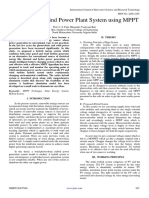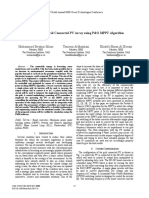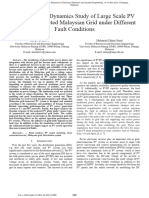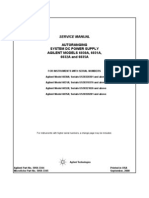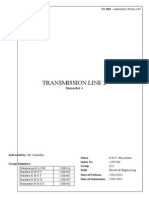Iccicct - 507 PDF
Iccicct - 507 PDF
Uploaded by
Glan DevadhasCopyright:
Available Formats
Iccicct - 507 PDF
Iccicct - 507 PDF
Uploaded by
Glan DevadhasOriginal Title
Copyright
Available Formats
Share this document
Did you find this document useful?
Is this content inappropriate?
Copyright:
Available Formats
Iccicct - 507 PDF
Iccicct - 507 PDF
Uploaded by
Glan DevadhasCopyright:
Available Formats
2014 International Conference on Control, Instrumentation, Communication and Computational Technologies (ICCICCT)
Implementation of Renewable Resources for Increased
Power Demand In Modern Era
Bibin Raj V.S Dr. Glan Devadas
Department of Electrical Engineering Dept of Electronics and Instrumentation
Heera College of Engineering and Technology Trivandrum, Noorul Islam University
India. Kumaracoil, India.
be met with the renewable sources (wind, solar) or energy storage
Abstract:- The human activities contribute to the global warming of or both. “Mitigation of short-term solar power intermittency and
the planet. As a result, every country strives to reduce carbon wind gust effects and minimizing its impacts on voltage,
emissions. The world is facing not only the depletion of fossil fuels, frequency, and power fluctuations in power system” [11] and
but also it’s rising prices which cause the worldwide economic
“Lowering the transmission and distribution costs by increasing
instability. By the nomenclature it is derived that the new demand
for power has been compensated by the implementation of soalr the confidence in renewable distributed generation”.[11] are
electric and photovoltaic technology. This implant a helping hand desired to be some of the key benefits for Improving power
for the upcoming needs for the economic growth of the nation and system stability, reduction of harmonics.
the speed growing power generation technology. The main intend is
to create a new system which incorporates the working PV S ystem Energy storage plays a crucial role not only in maintaining
to load and the power electronics and the methodology to track the system reliability but also in insuring energy efficiency and
solar path by introducing the MPP tracking. Because of that the power quality. The role of storage in power system determines
efficiency can be increased further and thus can improve the the size and type of storage used. The problem is to analyze the
utilization factor. Then main prominence is to be placed on the
domain of application of the storage system. With an appropriate
photovoltaic system, the modeling and simulation of photovoltaic
array, the MPP control and the DC/DC converter. The S imulink choice of storage parameters, the storage unit may be used as
model of the PV could be used in the future for extended study with multifunctional device, able to solve a wide number of problems.
different DC/DC converter topology. Optimization of MPPT The combination of storage with grid connected PV system is
algorithm can be implemented with the existing Photovoltaic and beneficial. According to [8] IEC 61727, the DC current injected
DC/DC converter. should be less than “0.5% of rated inverter output current into the
utility AC interface.” The DC current could produce inundation
Keywords—PV;MPPT; dc-dc converter; inverter; renewable of the delivery converters within the grid.
energy sources; control algorithum.
According to [7], the PV systems should have a fixed
I. INT RODUCT ION
frequency between 59.3 – 60 Hz. The PV systems should stay
To face the challenges on rising demands on global electric synchronized with the grid. For small PV systems, the frequency
power some regulatory guidelines are adopted of best practices by trip should be 59.2 Hz and 60.6 Hz. When there is variation of
utilities in terms of the Smart Grid and renewable energy frequency outside the range specified above, the inverter has to
applications. Smart Grid organization provides the consumers stop energizing the line of utility within a span of over six cycles.
with the ability to monitor and control energy consumption. By The time delay is set to avoid the PV to trip for short time
using the Smart Grid, energy consumers will have a motivation to disturbance.
create power on their own with the use of wind turbines or solar
paneling etc. Even though the output efficiency is too low from a The paper describes the physical effect of the PV system in
PV cell the installation and maintenance is bit easier in all means. combination with the developed MPP controller. A mathematic
It also offers a wide range of domestic and industrial applications. model, the photovoltaic systems, DC-DC boost-buck, boost, buck
In isolated applications PV system is directly connected and converter, MPP controller etc. have been designed. The system
coupled with a load and storage system. Thus it improves the has been demonstrated with the MATLAB.
utility of the system.
II. TOPOLOGY
The main benefit of integrating storage with renewable A. Topology of PV Module
energy is the capability of shifting the peak demands using
different technical strength. The storage can be charged from the Soeren Baekhoej et al. [4] did a classification of Inverter
renewable sources or from the grid. The demand on the grid can Topologies for photovoltaic system. The inverter could be a
978-1-4799-4190-2/14/$31.00 ©2014 IEEE 1468
2014 International Conference on Control, Instrumentation, Communication and Computational Technologies (ICCICCT)
single stage inverter, dual stage inverter. Each topology has their PWM full bridge inverter, switched at great frequencies improves
advantages and disadvantages. An optimization is necessary for the efficiency of the system.
the choice of topology. The topology should guarantee that the
output current is a high quality sine wave and in phase with
voltage if grid connected, also with low distortion harmonic.
Fig 2: Circuit diagram of DC/AC grid-connected PV system
III. M AXIMUM POWER POINT CONT ROLLER AND
A LGORIT HUM
Since the Photovoltaic has a non-linearity characteristic,
maximum power point controller allows operating the
photovoltaic array at MPP. The MPPT adjust the pulse width of
the DC/DC converter or DC/AC of the inverter. Cited below are
different strategies to obtain the MPP for the PV system.
G. M. S. Azevedo et al. use this method in [3]. It tries to
measure the prior value’s power in terms of the new value and
then makes the decision of whether the voltage for the PV array
can be increased or decreased. The reference voltage value is
adjusted until the maximum power point is reached. In [3], two
parameters control the MPP: the sample rate and the reference
voltage. With this method, the DC link voltage wavers o ver the
Fig 1: T opology of PV Module
supreme point of power. The voltage is increased or decreased
Central inverter topology can be called also single stage with constant value ΔV. The choice of ΔV determines how fast
photovoltaic system. In this topology, the photovoltaic system the MPP controller tracks the voltage. It is important to note that
includes a series-parallel connection arrangement, which is the reference voltage and MPP never coincide in steady state. The
connected to a single inverter DC/AC for the transfer of higher output voltage of the PV oscillates and causes loss of energy.
amount of power possible to the grid or the load. Single stage
photovoltaic has one inverter DC/AC that must handle the A P&O algorithm is used in [9] to interface the PV module
MPPT, control the current on the grid along with the to the grid. A boost converter is used to step up the voltage from
amplification of the voltage, which makes the single stage more the PV system and a single-phase inverter DC/AC is used for the
complex to control. Sachin Jain et al. proposed, “Using connection to the grid. According to Fangrui Lui et al [9], in the
conventional H-bridge inverter followed by step up transformer event that the solar irradiation goes through a change, the
or using a PV array with sufficiently large PV voltage.” [5] Thus, voltage that is being output is prone to faster stabilization, 4 to 5
the boost converter is no longer necessary. However, the extra cycles with P&O method, instead of 12 cycles with Hill
transformer adds up to the cost and the size of the PV system. In climbing. Although the P&O algorithm is typically seen as more
addition, the large PV array has the disadvantage of “reduced appropriate in comparison to Hill climbing, , P&O method tends
safety and increased probability of leakage current through the to oscillate about the MPP. In [9], with larger step size, PV
parasitic capacitance between the panel and the system ground.” voltage and output power result in ripples of a considerable size,
[5]. in single stage PV system, the dc/ac inverter must ensure all and the dc capacitor, which is paralleled with the PV arrays,
the functions: MPPT, boosting and inversion as shown in figure
undergoes tremendous over and under voltages that can lead to
2.
the deterioration of the PV converter’s performance.
In [6] Martina Calais et al. defined the central inverter
topology as cheap, robust and highly efficient. The major MPPT INC method is used to feed a DC motor pump in
disadvantage is the low power factor 0.6 and 0.7. The actual [10]. INC has higher tracking performance compared to P&O.
The transient of the motor is better with INC MPPT when the
978-1-4799-4190-2/14/$31.00 ©2014 IEEE 1469
2014 International Conference on Control, Instrumentation, Communication and Computational Technologies (ICCICCT)
irradiance and cell temperature are constant. The tracking but have a power factor between 0.6 and 0.7. Self-commutated
efficiency result is 99.73% with step size 0.02% when a step inverters are used quite often; they are capable switching at high
change of irradiance and temperature are applied. frequency, which introduce more losses in semiconductor. The
self-commutated inverter is robust and cheap technology.
The boost converter is widely used to pinpoint the ultimate
point of power of the PV array. It is a simple circuit with good IV. PI CONT ROLLER WIT H FORWARD COMPENSAT ION
response speed. Any algorithm of maximum power point is
flexible to implement with software and hardware. The boost
converter circuit is shown in figure 3
Fig 5 PID Controller with feed forward compensation
Fig 3: Boost Converter
The modulation used to command the three-phase inverter is
space vector Pulse width modulation (SVPWM). This technique
is largely used in power electronics nowadays and is easier to
A boost buck-boost converter to find the MPP of the implement digitally. The basic techniques are the same for three-
photovoltaic array. The buck-boost stage tracks the maximum phase inverter. Jiyong Li et al. [1] have proposed a Space vector
power by matching the output load to the optimal photovoltaic PWM control scheme for three-phase PWM inverter in PV
impedance. The two power stages shown in figure 4 worked generation system. Each state voltage is calculated from the Vdc
independently, solving the problem of ineffectiveness, and input voltage of the inverter. The reference voltage vector is
transfer efficiency. The buck-boost tracks the maximum power in calculated within the appropriate region for the purpose of
continuous conduction mode and the boost minimizes the PV minimizing the time for switching along with current harmonics
current ripple. [1]. At first, the voltage in αβ reference frame is determined, then
the duration period T 1 and T2 time duration for each vector in
each PWM cycle. The advantages with SVPWM modulation
techniques are “low total harmonic distortion (THD), constant
switching frequency, well-defined output harmonic spectrum,
optimum switching pattern and excellent dc-link voltage
utilization” [1].
The simulation of the Boost converter, the photovoltaic
array and maximum power point controller in Simulink is shown
Fig 4: Dual stage Boost Buck Boost 1 in the figure6. The system has a resistive load to test the
simulation.
The function of the DC/AC inverter is presented in [4]. It
should mold the current into a waveform i.e. sinusoidal, and The simulation presents an analysis of the photovoltaic
subsequently transform the current to ac current with low array 12000W with the boost converter to track the maximum
harmonics content. The PV array is used to inject a sinusoidal power point. The PV system parameters are:
current to the grid. The topology adopted depends on the
application whether it is a standalone PV system or grid DC bus voltage Vdc: 540 V (nominal), 200 V
connected. (min)
AC output voltage of the inverter: 208 V ( LL),
The typical DC/AC inverter could be a line frequency - 120 V (L-N), 60 Hz
commutated current source inverter (CSI), a full-bridge three- The boost input voltage nominal is 337 V and, the
level, half-bridge diode clamped three-level VSI, etc. In [4], line output voltage is 540 V.
commutated inverters are qualified robust, efficient and cheap
978-1-4799-4190-2/14/$31.00 ©2014 IEEE 1470
2014 International Conference on Control, Instrumentation, Communication and Computational Technologies (ICCICCT)
Maximum power point controller is used to control the converter, MPP controller etc. have been designed. The system
boost converter. Perturb and Observe algorithm is implemented to has been demonstrated with the MATLAB. Form the simulations
track the maximu m power of the PV module. it is identified that the results from the data sheet matches the
obtained result. The designed algorithm can track the MPP of a
specific PV module. By this the efficiency can be improved. The
output verifies the effect of different physical parameters such as
irradiance, temperature, load variations, Converter outputs etc..
The DC voltage generated by the PV array can generate a
sinusoidal alternating current at the output of the inverter is
detected. The power of PV cell describes the amplitude of current
and the voltage at unambiguous working stipulation.
REFERENCES
[1] Jiyong Li and Honghua Wang, “A Novel Stand-alone PV generation
System based on Variable Step Size INC MPPT and SVPWM
control,” Power Electronics and Motion Control Conference, 2009.
IPEMC '09. IEEE 6th International, July 2009, pp. 2155 - 2160.
Fig 6: Simulink model of the PV system with MPPT
[2] Zeng, Q., Chang L. and Song, P., “SVPWM-based Current controller
with Grid Harmonic Compensation for three-phase grid connected
V. BOOST CONVERT ER, OUT PUT POWER, VOLT AGE AND VSI,” Power Electronics Specialists Conference, 2004. PESC 04.
CURRENT 2004 IEEE 35th Annual, vol. 4, April 2005 pp. 2494 - 2500.
The same simulation is performed to test the performance of [3] Azevedo, G.M.S., Cavalcanti, M.C., Oliveira, K.C., Neves, F.A.S.
and Lins, Z.D., “Evaluation of maximum power point tracking
the boost converter. Figures, respectively the output power, methods for grid connected photovoltaic systems,” Conference on
voltage and current of the boost converter. The output power of Power Electronics Specialists, 2008. PESC 2008. IEEE , August
the boost converter is still 12000 W when the irradiance is at 2008, pp. 1456 – 1462
1000. [4] Kjaer, S.B., Pedersen, J.K. and Blaabjerg, F., “A Review of single-
phase grid connected inverters for photovoltaic modules,” Industry
Applications, IEEE Transactions , vol. 41, September 2005, pp.1292-
1306.
[5] Jain, S. and Agarwal, V., “A single-stage grid connected inverter
topology for solar PV systems with maximum power point tracking,”
IEEE Transactions on Power Electronics, vol. 22, September 2007,
pp. 1928-1940.
[6] Calais, M., Myrzik, J., Spooner, T. and Agelidis, V.G., “ Inverters for
single-phase grid connected photovoltaic systems – an overview,”
Power Electronics Specialists Conference, 2002. pesc 02. 2002 IEEE
33rd Annual, vol. 4, November 2002,pp. 1995 - 2000.
Fig 7 Output at different stages
[7] IEEE Std. 929-2000, “IEEE Recommended Practice for Utility
Interface of Photovoltaic (PV) Systems”, 2000
The simulation is run with resistive load of 24.3 ohm at the
terminal of the boost converter. The PV is set at irradiance equal [8] IEC 61727 second edition 2004, “International standard, Photovoltaic
to one and temperature to 25ºC. The left side is the photovoltaic (PV) systems- Characteristics of the utility interface”, 2004
voltage, current and power. In addition, the right side is the load
[9] Fangrui Liu, Yong Kang, Yu Zhang and Shanxu Duan, “Comparison
voltage, current and power, which is the boost converter output. of P&O and hill Climbing MPPT methods for grid-connected PV
Moreover, the boost converter increases the voltage up to 540 V. converter,” 3 rd IEEE Conference on Industrial Electronics and
The output power is equal to the input power, which gives the Applications, 2008. August 2008, pp. 804 – 807
output current 22.22 A. The boost converter was able to track
[10] Elgendy, M.A., Zahawi, B., Atkinson, D.J., “ Analysis of the
the maximu m power of the PV by variation of its duty cycle. performance of DC Photovoltaic systems with maximum power point
tracking,”4 th IET Conference on Power Electronics, Machines and
VI. CONCLUSION Drives, 2008. PEMD 2008., May 2008, pp. 426 - 430.
The paper describes the physical effect of the PV system in
combination with the developed MPP controller. A mathematic [11] Nasiri, A. “ Integrating energy storage with renewable energy
systems”, Industrial Electronics, 2008. IECON 2008. 34th Annual
model, the photovoltaic systems, DC-DC boost-buck, boost, buck Conference of IEEE, 10-13 Nov. 2008, pp. 18
978-1-4799-4190-2/14/$31.00 ©2014 IEEE 1471
2014 International Conference on Control, Instrumentation, Communication and Computational Technologies (ICCICCT)
978-1-4799-4190-2/14/$31.00 ©2014 IEEE 1472
You might also like
- A Maximum Power Point Tracking System With Parallel Connection For PV Stand-Alone ApplicationsDocument10 pagesA Maximum Power Point Tracking System With Parallel Connection For PV Stand-Alone ApplicationsJidhin JayanNo ratings yet
- Deriving Inertial Response From A Non-Inertial PV System For Frequency RegulationDocument5 pagesDeriving Inertial Response From A Non-Inertial PV System For Frequency RegulationGustavoAndresEscobarParedesNo ratings yet
- Intelligent MPPT Control For SEPIC-Luo Converter in Grid Tied Photovoltaic SystemDocument11 pagesIntelligent MPPT Control For SEPIC-Luo Converter in Grid Tied Photovoltaic SystemInternational Journal of Applied Power EngineeringNo ratings yet
- Direct Control of Active and Reactive Power For A Grid-Connected Single-Phase Photovoltaic InverterDocument12 pagesDirect Control of Active and Reactive Power For A Grid-Connected Single-Phase Photovoltaic InverterInternational Journal of Power Electronics and Drive SystemsNo ratings yet
- An Efficient Constant Current Controller For PV Solar Power Generator Integrated With The GridDocument6 pagesAn Efficient Constant Current Controller For PV Solar Power Generator Integrated With The GridsunilkumareceNo ratings yet
- Ijirt Paper 2Document5 pagesIjirt Paper 2dineshkumarNo ratings yet
- 2013c - Sliding Mode Control Based Power Balancing For Grid ConnectedDocument6 pages2013c - Sliding Mode Control Based Power Balancing For Grid ConnectedP. K. SahuNo ratings yet
- ABSTRACTDocument19 pagesABSTRACTlifeofhope173No ratings yet
- FPPT 3Document6 pagesFPPT 3Sarath ReddyNo ratings yet
- A Three-Phase Grid Tied SPV System With Adaptive DC Link Voltage For CPI Voltage VariationsDocument8 pagesA Three-Phase Grid Tied SPV System With Adaptive DC Link Voltage For CPI Voltage VariationsAshwani GargNo ratings yet
- Single-Phase Grid-Connected PV System With Golden Section Search-Based MPPT AlgorithmDocument12 pagesSingle-Phase Grid-Connected PV System With Golden Section Search-Based MPPT AlgorithmGobu PatnaikNo ratings yet
- Design and Implementation of Three Phase To Single Phase Solid State TransformerDocument37 pagesDesign and Implementation of Three Phase To Single Phase Solid State TransformerUsha SreeNo ratings yet
- A New Fuzzy Based INC MPPT Algorithm ForDocument6 pagesA New Fuzzy Based INC MPPT Algorithm Forcharushila patelNo ratings yet
- Maximum Power Point Controller For Large-Scale Photovoltaic Power Plants Using Central Inverters Under Partial Shading ConditionsDocument13 pagesMaximum Power Point Controller For Large-Scale Photovoltaic Power Plants Using Central Inverters Under Partial Shading ConditionsIman AshrafNo ratings yet
- A Grid Tied SPV System With Adaptive DC Link Voltage For CPI Voltage Variations Using Fuzzy Logic ControlDocument9 pagesA Grid Tied SPV System With Adaptive DC Link Voltage For CPI Voltage Variations Using Fuzzy Logic ControlAbhinav ShendageNo ratings yet
- Ravichandran Chinnappan, Premalatha Logamani and Rengaraj RamasubbuDocument17 pagesRavichandran Chinnappan, Premalatha Logamani and Rengaraj RamasubbuBOOPATHI YADAVNo ratings yet
- Modelling and Simulation of Hybrid Wind SystemDocument2 pagesModelling and Simulation of Hybrid Wind SystemAkshayHanumanteNo ratings yet
- Hybrid Solar-Wind Power Plant System Using MPPTDocument3 pagesHybrid Solar-Wind Power Plant System Using MPPTInternational Journal of Innovative Science and Research TechnologyNo ratings yet
- Modified PDPWM Control With MPPT Algorithm For Equal Power Sharing in Cascaded Multilevel Inverter For Standalone PV System Under Partial ShadingDocument13 pagesModified PDPWM Control With MPPT Algorithm For Equal Power Sharing in Cascaded Multilevel Inverter For Standalone PV System Under Partial ShadingInternational Journal of Power Electronics and Drive SystemsNo ratings yet
- 48 An Improved Maximum Power Point Tracking For PDFDocument10 pages48 An Improved Maximum Power Point Tracking For PDFSouhaib LoudaNo ratings yet
- Control of Grid Connected PV Array Using P&O MPPT AlgorithmDocument7 pagesControl of Grid Connected PV Array Using P&O MPPT AlgorithmHương B DlightNo ratings yet
- PV SystemDocument7 pagesPV SystemgetanehrsNo ratings yet
- Reactive Power Control of Grid-Connected Photovoltaic Micro-Inverter Based On Third-Harmonic InjectionDocument13 pagesReactive Power Control of Grid-Connected Photovoltaic Micro-Inverter Based On Third-Harmonic InjectionInternational Journal of Power Electronics and Drive SystemsNo ratings yet
- Machine Learning Based Cascaded ANN MPPT Controller For Erratic PV Shading CircumstancesDocument10 pagesMachine Learning Based Cascaded ANN MPPT Controller For Erratic PV Shading CircumstancesInternational Journal of Power Electronics and Drive SystemsNo ratings yet
- Modeling and Simulation of A GRID-TIED Solar PV System: K.Sakthivel, V.Jayalakshmi, G.RajakumariDocument7 pagesModeling and Simulation of A GRID-TIED Solar PV System: K.Sakthivel, V.Jayalakshmi, G.RajakumariChairul AkbarNo ratings yet
- Energy Conversion and Management: Z. Zhou, P.M. Holland, P. IgicDocument10 pagesEnergy Conversion and Management: Z. Zhou, P.M. Holland, P. IgicjulioNo ratings yet
- Frequency and Voltage Stabilit-IRO-Journals-4 4 4Document20 pagesFrequency and Voltage Stabilit-IRO-Journals-4 4 4aliebadizahedan.375No ratings yet
- Model Predictive Current Control For Maximum Power Point Tracking of Voltage Source Inverter Based Grid Connected Photovoltaic SystemDocument10 pagesModel Predictive Current Control For Maximum Power Point Tracking of Voltage Source Inverter Based Grid Connected Photovoltaic SystemInternational Journal of Power Electronics and Drive SystemsNo ratings yet
- Analysis and Implement of Hybrid ANN PandO Based MPPT Controller To Enhance Efficiency of Photovoltaic SystemDocument12 pagesAnalysis and Implement of Hybrid ANN PandO Based MPPT Controller To Enhance Efficiency of Photovoltaic SystemEditor IJTSRDNo ratings yet
- Review Article: Research Survey On Various MPPT Performance Issues To Improve The Solar PV System EfficiencyDocument21 pagesReview Article: Research Survey On Various MPPT Performance Issues To Improve The Solar PV System EfficiencyShubhamNo ratings yet
- A Study On Grid Connected PV System: Under Supervision by EachDocument14 pagesA Study On Grid Connected PV System: Under Supervision by EachAnan OthmanNo ratings yet
- Firdaus 2019Document10 pagesFirdaus 2019Neethu Elizabeth MichaelNo ratings yet
- SpeicinternDocument34 pagesSpeicintern4PS20EE018Kruthik GowdaNo ratings yet
- Doi 10.1016 J.enconman.2006.04.022Document9 pagesDoi 10.1016 J.enconman.2006.04.022fong jeffNo ratings yet
- PSCAD EMTD Model Of3phase Grid Connected Photovoltaic Solar System PDFDocument7 pagesPSCAD EMTD Model Of3phase Grid Connected Photovoltaic Solar System PDFcarlos cervantesNo ratings yet
- A Two-Stage Single-Phase Grid-Connected Solar-PV System With Simplified Power RegulationDocument12 pagesA Two-Stage Single-Phase Grid-Connected Solar-PV System With Simplified Power RegulationMEr YemNo ratings yet
- Inverter Based Implementation of Maximum Power Point TechniquesDocument8 pagesInverter Based Implementation of Maximum Power Point TechniquesInternational Journal of Applied Power EngineeringNo ratings yet
- Optimization of Fractional Order PI Controller To Regulate Grid Voltage Connected Photovoltaic System Based On Slap Swarm AlgorithmDocument17 pagesOptimization of Fractional Order PI Controller To Regulate Grid Voltage Connected Photovoltaic System Based On Slap Swarm AlgorithmInternational Journal of Power Electronics and Drive SystemsNo ratings yet
- A Simple Efficient and Novel Standalone Photovoltaic Inverter Configuration With Reduced Harmonic DistortionDocument15 pagesA Simple Efficient and Novel Standalone Photovoltaic Inverter Configuration With Reduced Harmonic DistortionD SHOBHA RANINo ratings yet
- 2-Stability and Reliability Improvement in Solar Wind Hybrid Power System With Battery Energy Storage StationDocument9 pages2-Stability and Reliability Improvement in Solar Wind Hybrid Power System With Battery Energy Storage StationEngrImranKhanNo ratings yet
- Energy Conversion and Management: Kamel Barra, Djamel RahemDocument10 pagesEnergy Conversion and Management: Kamel Barra, Djamel Rahemchikha saidNo ratings yet
- Improvement of Power Quality For Operation of The Grid-Connected Photovoltaic Energy System Considering The Irradiance UncertaintyDocument4 pagesImprovement of Power Quality For Operation of The Grid-Connected Photovoltaic Energy System Considering The Irradiance Uncertainty2021809568No ratings yet
- 189 839 1 PB2Document10 pages189 839 1 PB2vivian phamNo ratings yet
- Electrical Power and Energy Systems: Reza Noroozian, Gevorg B. GharehpetianDocument8 pagesElectrical Power and Energy Systems: Reza Noroozian, Gevorg B. GharehpetianAntar BeddarNo ratings yet
- Effect of Partial Shading in Grid Connected Solar PV System With FL ControllerDocument10 pagesEffect of Partial Shading in Grid Connected Solar PV System With FL ControllerPtuan ThanhNo ratings yet
- Solar - Photovoltaic - Generators - With - MPPT - and - BatterDocument12 pagesSolar - Photovoltaic - Generators - With - MPPT - and - BatterCB MildredNo ratings yet
- Prerna 2016Document5 pagesPrerna 2016Jorge CarrionNo ratings yet
- AIMS Energy - FinalDocument15 pagesAIMS Energy - FinalKhan farazNo ratings yet
- Enhancing Solar Photovoltaic System Efficiency A Comparative Analysis of Intelligent ANN PandO MPPT Controller Against Traditional AlgorithmsDocument10 pagesEnhancing Solar Photovoltaic System Efficiency A Comparative Analysis of Intelligent ANN PandO MPPT Controller Against Traditional AlgorithmsEditor IJTSRDNo ratings yet
- IJSRET V8 Issue6 495Document8 pagesIJSRET V8 Issue6 495vikram sirohiNo ratings yet
- Analysis of PQ Problems in Solar Power Distribution System PDFDocument7 pagesAnalysis of PQ Problems in Solar Power Distribution System PDFEmmanuel Esteban SebanstianNo ratings yet
- Ice Pes 2016 Paper 157Document6 pagesIce Pes 2016 Paper 157DhavalNo ratings yet
- A MMC Based Three-Phase Wind Energy Inverter (WEI) With Flexible AC Transmission SystemDocument6 pagesA MMC Based Three-Phase Wind Energy Inverter (WEI) With Flexible AC Transmission SystemInternational Journal of Engineering and TechniquesNo ratings yet
- Midterm Report: in Electrical EngineeringDocument11 pagesMidterm Report: in Electrical Engineeringdr.Sabita shresthaNo ratings yet
- 10 1109@access 2020 2964052 PDFDocument10 pages10 1109@access 2020 2964052 PDFsamraat sharmaNo ratings yet
- A Robust Nonlinear Control Strategy of A PV System Connected To The Three-Phase Grid Based On Backstepping and PSO TechniqueDocument15 pagesA Robust Nonlinear Control Strategy of A PV System Connected To The Three-Phase Grid Based On Backstepping and PSO TechniqueInternational Journal of Power Electronics and Drive SystemsNo ratings yet
- Kaliamoorthy2015 PDFDocument10 pagesKaliamoorthy2015 PDFkhalidNo ratings yet
- FluidMech 2014 4Document55 pagesFluidMech 2014 4Glan DevadhasNo ratings yet
- Marine Pollution Bulletin 158 (2020) 111352Document4 pagesMarine Pollution Bulletin 158 (2020) 111352Glan DevadhasNo ratings yet
- Utilization of Polymer Wastes As Transport Fuel Resources-A Recent DevelopmentDocument5 pagesUtilization of Polymer Wastes As Transport Fuel Resources-A Recent DevelopmentGlan DevadhasNo ratings yet
- 0hfkdqlfdodqgzhduehkdylrxuridoxplqlxp Phwdopdwul (K/EulgfrpsrvlwhvDocument10 pages0hfkdqlfdodqgzhduehkdylrxuridoxplqlxp Phwdopdwul (K/EulgfrpsrvlwhvGlan DevadhasNo ratings yet
- Design of An IMCPID Optimized Neural Network For SDocument19 pagesDesign of An IMCPID Optimized Neural Network For SGlan DevadhasNo ratings yet
- 5350 Mass and Momentum EquationsDocument12 pages5350 Mass and Momentum EquationsGlan DevadhasNo ratings yet
- Apj Abdul Kalam Technological University: Part A No MarksDocument1 pageApj Abdul Kalam Technological University: Part A No MarksGlan DevadhasNo ratings yet
- 10 11648 J Ijsts 20140206 15 PDFDocument6 pages10 11648 J Ijsts 20140206 15 PDFGlan DevadhasNo ratings yet
- s13068 019 1529 1 PDFDocument58 pagess13068 019 1529 1 PDFGlan DevadhasNo ratings yet
- Utilization of Polymer Wastes As Transport Fuel Resources-A Recent DevelopmentDocument5 pagesUtilization of Polymer Wastes As Transport Fuel Resources-A Recent DevelopmentGlan DevadhasNo ratings yet
- Introduction To International Electro Technical Commission (IEC) 61131-3Document38 pagesIntroduction To International Electro Technical Commission (IEC) 61131-3Glan Devadhas100% (1)
- s13068 019 1529 1 PDFDocument58 pagess13068 019 1529 1 PDFGlan DevadhasNo ratings yet
- Marine Pollution Bulletin 158 (2020) 111352Document4 pagesMarine Pollution Bulletin 158 (2020) 111352Glan DevadhasNo ratings yet
- Introduction To MATLAB 7 For EngineersDocument22 pagesIntroduction To MATLAB 7 For EngineersGlan DevadhasNo ratings yet
- Engg1801 2005 Lect2Document12 pagesEngg1801 2005 Lect2Glan DevadhasNo ratings yet
- Name: ................................... Reg. No.:........................Document2 pagesName: ................................... Reg. No.:........................Glan DevadhasNo ratings yet
- 10CE6202: Construction Personnel Management: Apj Abdul Kalam Technological UniversityDocument2 pages10CE6202: Construction Personnel Management: Apj Abdul Kalam Technological UniversityGlan DevadhasNo ratings yet
- MATLAB For Engineering ApplicationsDocument208 pagesMATLAB For Engineering ApplicationsGlan DevadhasNo ratings yet
- Lecture #1 Fundamentals of Data Communications: E-626-A Data Communication and Industrial Networks (DC-IN)Document20 pagesLecture #1 Fundamentals of Data Communications: E-626-A Data Communication and Industrial Networks (DC-IN)Glan DevadhasNo ratings yet
- Reg No.: - Name: - : MarksDocument2 pagesReg No.: - Name: - : MarksGlan DevadhasNo ratings yet
- Automatic Bottle Filling System: Presented byDocument13 pagesAutomatic Bottle Filling System: Presented byGlan Devadhas100% (1)
- Matlab IntroDocument25 pagesMatlab IntroGlan DevadhasNo ratings yet
- Automatic Empty Bottle Detection Using PLC Logic - Instrumentation ToolsDocument13 pagesAutomatic Empty Bottle Detection Using PLC Logic - Instrumentation ToolsGlan DevadhasNo ratings yet
- Catálogo Borracha QuantiqDocument2 pagesCatálogo Borracha QuantiqCelso VernarecciaNo ratings yet
- Practice #3 Power Control Circuit With SCR: PurposeDocument3 pagesPractice #3 Power Control Circuit With SCR: PurposeiramNo ratings yet
- HMZ - 433 Sensor de HumedadDocument4 pagesHMZ - 433 Sensor de HumedadLeo BarrazaNo ratings yet
- VLSI Question BankDocument2 pagesVLSI Question BankVikash SharmaNo ratings yet
- Manual de Servicio Pioneer 2700Document152 pagesManual de Servicio Pioneer 2700Carlos Alonso Gonzalez VazquesNo ratings yet
- Expt 3 - EEM - Dielectric Strength of Liquid Insulating MaterialDocument6 pagesExpt 3 - EEM - Dielectric Strength of Liquid Insulating MaterialAvaniPujaraNo ratings yet
- Current Versus Gate Voltage Hysteresis in Organic Field Effect TransistorsDocument16 pagesCurrent Versus Gate Voltage Hysteresis in Organic Field Effect Transistorsajayiitm05No ratings yet
- Serv Ice Manual: HS-2580 Colour TelevisionDocument51 pagesServ Ice Manual: HS-2580 Colour TelevisionJazziel DomínguezNo ratings yet
- ADocument140 pagesAjmt_grauballeNo ratings yet
- Assignment 1 Machine and DrivesDocument2 pagesAssignment 1 Machine and DrivesChawyang CheahNo ratings yet
- EPSON Stylus Color 480SXU 580 SM PDFDocument150 pagesEPSON Stylus Color 480SXU 580 SM PDFRoland A. LeiteNo ratings yet
- Transmission Line 2: SemesterDocument12 pagesTransmission Line 2: SemesterNipuna Thushara WijesekaraNo ratings yet
- Castells and HallDocument18 pagesCastells and HallAngiie RamirezNo ratings yet
- CVP Manual (English) V07Document52 pagesCVP Manual (English) V07gilbert einsteinNo ratings yet
- Operating Manual: I. General Introduction II. Symbol DescriptionDocument2 pagesOperating Manual: I. General Introduction II. Symbol DescriptionAhmad MohamedNo ratings yet
- Razavi - HW 1Document6 pagesRazavi - HW 1Shubham GuptaNo ratings yet
- Adr 132 BDocument5 pagesAdr 132 Btandin tshewangNo ratings yet
- LM555 and LM556 Timer CircuitsDocument69 pagesLM555 and LM556 Timer CircuitskatambarogersNo ratings yet
- Micro Machining of Metals, Ceramics, Silicon and Polymers Using Nanosecond LasersDocument11 pagesMicro Machining of Metals, Ceramics, Silicon and Polymers Using Nanosecond LasersglzrNo ratings yet
- Sheet 1Document2 pagesSheet 1Hasnaa MahmoudNo ratings yet
- Diode Data Sheet 1N4149Document2 pagesDiode Data Sheet 1N4149Michael SmithNo ratings yet
- Feature: NPN Silicon General Purpose Transistor Elektronische BauelementeDocument1 pageFeature: NPN Silicon General Purpose Transistor Elektronische BauelementeRichard Hernandez RuizNo ratings yet
- Switchboard Electrical TestsDocument4 pagesSwitchboard Electrical TestsTTaanNo ratings yet
- ECSS Q ST 70 08C (6march2009)Document106 pagesECSS Q ST 70 08C (6march2009)Udo WinklerNo ratings yet
- CompositesDocument60 pagesCompositesmudassarahmed13100% (1)
- Tl494 App ReportDocument31 pagesTl494 App ReportGamal Yones100% (1)
- Chemical Sensors: Comprehensive Sensor Technologies, Vol. 4: Solid State SensorsDocument65 pagesChemical Sensors: Comprehensive Sensor Technologies, Vol. 4: Solid State SensorsMomentum Press100% (3)
- Earthing ResistanceDocument4 pagesEarthing ResistanceNeeraj Purohit100% (1)
- Course Objective: To Design Microwave AmplifierDocument3 pagesCourse Objective: To Design Microwave AmplifierAshwini KothavaleNo ratings yet
- Methodology: Phase-I: Designing and Procurement of ComponentsDocument7 pagesMethodology: Phase-I: Designing and Procurement of ComponentsBhavya SachdevaNo ratings yet

















